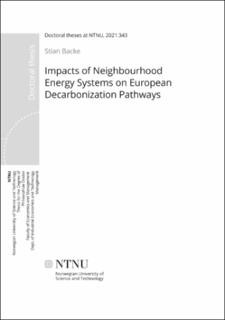| dc.contributor.advisor | Tomasgard, Asgeir | |
| dc.contributor.advisor | Korpås, Magnus | |
| dc.contributor.author | Backe, Stian | |
| dc.date.accessioned | 2022-01-26T07:38:03Z | |
| dc.date.available | 2022-01-26T07:38:03Z | |
| dc.date.issued | 2021 | |
| dc.identifier.isbn | 978-82-326-6904-2 | |
| dc.identifier.issn | 2703-8084 | |
| dc.identifier.uri | https://hdl.handle.net/11250/2839333 | |
| dc.description.abstract | Variable renewable energy sources are likely to dominate the European electricity market within the next few decades, and understanding the impacts and consequences of this is a common research topic today. Much of existing research focus on the supply side of electricity markets, and there is an increasing need to also explore developments on the demand side. Buildings account for about 40% of final energy use in Europe and are traditionally consumers of electricity and heat. More recently, neighbourhoods are increasingly able to produce their own electricity and provide comfort and services ever more flexibly and energy efficiently. There is an overlap between the future energy system and neighbourhoods, yet their sectoral relationship is still not completely understood. This thesis explores transition pathways towards a decarbonized European energy system with a focus on distributed energy resources in neighbourhoods. The first part of this thesis takes a bottom-up perspective on the neighbourhood level, which includes developing and using mathematical programming models to explore how electricity billing structures for neighbourhood stakeholders can incentivize efficient utilization of distributed energy resources. The second part of this thesis takes a top-down perspective on the European level, which includes developing and using multi-horizon stochastic programming to analyze investments in the European electricity and heat system while considering variable and uncertain operations on a country aggregated level. Findings imply that existing billing practices in neighbourhoods ought to be revised such that distributed energy resources are incentivized to efficiently utilize grid infrastructure when electricity loads are changing. This includes facilitating end-user price signals to be more dynamic and less dependent on individual metering. Further findings imply that the development of distributed energy resources in neighbourhoods significantly impacts the capacity expansion pathway for the future energy system at national and European level. Given fulfilment of EU decarbonization policy, neighbourhood energy systems compete with low-carbon sources in the surrounding energy system, and a wide deployment of distributed energy resources are found to increase cost-efficiency on the transition towards a decarbonized energy system. | en_US |
| dc.description.abstract | Sammendrag av avhandlingen
Variable fornybare energikilder vil trolig dominere det Europeiske kraftmarkedet innen få tiår, og et relativt vanlig forskningstema i dag er å studere innvirkningen og konsekvensene av dette. Mye av eksisterende forskning fokuserer på tilbudssiden i kraftmarkedet, og det finnes et økende behov for å studere muligheter og utvikling på etterspørselssiden. Bygg er tradisjonelle forbrukere av strøm og varme og utgjør omtrent 40% av energisluttbruken i Europa. Nabolag er stadig mer i stand til å produsere sin egen strøm, og komfort og tjenester i nabolaget kan tilbys stadig mer energieffektivt. Det er mye overlapp mellom fremtidens energisystem og nabolag, men samspillet mellom disse to sektorene er fremdeles ufullstendig forstått. Denne avhandlingen studerer overgangen til et avkarbonisert Europeisk energisystem med særlig fokus på distribuerte energiressurser i nabolag. Den første delen av avhandlingen utforsker dette temaet nedenfra og opp fra nabolagets perspektiv. Denne delen inkluderer utvikling og bruk av matematiske programmeringsmodeller for å studere hvordan avregningsstrukturer på nabolagsnivå kan gi insitamenter for effektiv utnyttelse av distribuerte energiressurser. Den andre delen av avhandlingen utforsker temaet ovenfra og ned fra et europeisk perspektiv. Denne delen inkluderer utvikling og bruk av multi-horisont stokastisk programmering for å studere investeringer i europeiske strøm- og varmemarkeder gitt variabel og usikker drift av energisystemet aggregert på landsnivå. Resultatene tyder på at eksisterende avregningsstrukturer i nabolag bør revideres slik at fleksibel bruk av distribuerte energiressurser blir belønnet for å bedre utnyttelsen av nettinfrastruktur ved økende elektrifisering. Dette inkluderer mer dynamiske sluttbrukerpriser som avhenger mindre av individuelt forbruk. Resultatene tyder også på at distribuerte energiressurser i nabolag i signifikant grad påvirker langsiktige investeringsbeslutninger i fremtidens energisystem, både på europeisk nivå og på landsnivå. Gitt at vi oppnår målene i europeisk klimapolitikk vil energisystemer i nabolag konkurrere med andre lavkarbon energikilder i det omkringliggende energisystemet, og en storskala utvikling av distribuerte energiressurser blir vist å redusere kostnadene ved å oppnå et avkarbonisert energisystem. | en_US |
| dc.language.iso | eng | en_US |
| dc.publisher | NTNU | en_US |
| dc.relation.ispartofseries | Doctoral theses at NTNU;2021:343 | |
| dc.relation.haspart | Paper 1: Backe, Stian; Kara, Güray; Tomasgard, Asgeir. Comparing individual and coordinated demand response with dynamic and static power grid tariffs. Energy 2020 ;Volum 201. s. 1-11 https://doi.org/10.1016/j.energy.2020.117619 This is an open access article under the CC BY license (http://creativecommons.org/licenses/by/4.0/). | en_US |
| dc.relation.haspart | Paper 2: Askeland, Magnus; Backe, Stian; Bjarghov, Sigurd; Korpås, Magnus. Helping end-users help each other: Coordinating development and operation of distributed resources through local power markets and grid tariffs. Energy Economics 2021 ;Volum 94. This is an open access article under the CC BY license (http://creativecommons.org/licenses/by/4.0/). | en_US |
| dc.relation.haspart | Paper 3: Backe, Stian; Korpås, Magnus; Tomasgard, Asgeir. Heat and electric vehicle flexibility in the European power system: A case study of Norwegian energy communities. International Journal of Electrical Power & Energy Systems 2021 ;Volum 125. https://doi.org/10.1016/j.ijepes.2020.106479 This is an open access article under the CC BY license (http://creativecommons.org/licenses/by/4.0/). | en_US |
| dc.relation.haspart | Paper 4: Emission reduction in the European power system: exploring the link between the EU ETS and net-zero emission neighbourhoods | en_US |
| dc.relation.haspart | Paper 5: Impact of Energy Communities on the European Electricity and Heat System Decarbonization Pathway: Comparing local and global flexibility responses | en_US |
| dc.title | Impacts of Neighbourhood Energy Systems on European Decarbonization Pathways | en_US |
| dc.type | Doctoral thesis | en_US |
| dc.subject.nsi | VDP::Social science: 200::Economics: 210::Economics: 212 | en_US |

